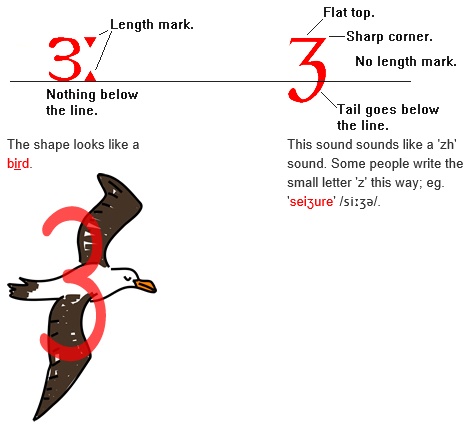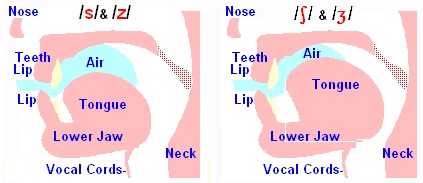Lesson 8
How to say it - /s/, /z/, /ʃ/ & /ʒ/ sounds
Introduction to /s/ & /z/
These consonants are spelt with the same letters as the symbols for the sounds, so /s/ = 's' and /z/ = 'z'. /s/ is also sometimes spelt 'ce'; eg. in distance. /z/ is sometimes spelled as 'z'; eg. in 'zoo', or 's'; eg. in 'roses'.
To make these sounds, touch your side teeth with the side of your tongue. Put your tongue forward.
The difference between /s/ and /z/ is that /s/ is an unvoiced sound, and /z/ is a voiced sound. In /z/ the air touches the vocal cords and makes them vibrate. In /s/ the air does not vibrate the vocal cords

Introduction to /s/ & /ʃ/
The difference between these consonants is a common problem because they are the same sound in some languages, but different sounds in English. The difference is important; eg. between 'sit' /sɪt/ and 'shit' /ʃɪt/. Sometimes the /ʃ/ sound is in a word, even if the letter is not there; eg. in 'sure' /ʃɔː/ and 'sugar' /ʃʊgə/.
In /ʃ/ the tongue is higher and further back than in /s/.

Introduction to /ʒ/
The is the sound in 'leisure' and 'Asia'. This sound is never at the start of English words, only at the start of foreign words used in English; eg. the famous film 'Dr. Zhivago'.
It is very easy to confuse the shape of the vowel /ɜː/ with the consonant /ʒ/. The differences are:

Introduction to /s/, /ʃ/, /z/ & /ʒ/
/s/ and /ʃ/ are unvoiced. /z/ and /ʒ/ are voiced. In /s/ and /z/ the tongue is lower and further forward than /ʃ/ and /ʒ/.
/s/ is sometimes spelt 'ce'; eg. in 'distance'. Sometimes the /ʃ/ sound is in a word, even if the letter 'h' is not there; eg. in 'sure' /ʃɔː/ and 'sugar' /ʃʊgə/. /ʒ/ is the sound in 'leisure'.

Video of Mouth
Follow the instructions as they appear in the video.